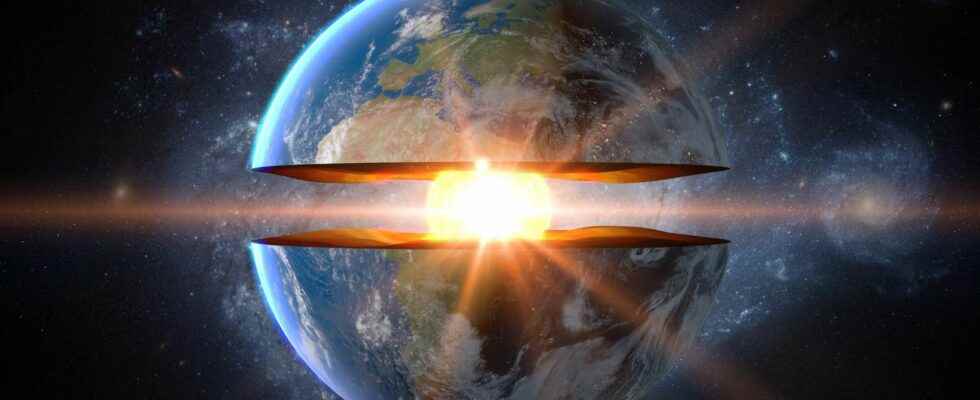You will also be interested
[EN VIDÉO] The core of the Earth reconstructed in the laboratory By spinning liquid sodium around a 23-tonne sphere, geophysicists at the University of Maryland simulate the conditions around our planet’s core. Goal of the game: to understand why the Earth is the only telluric planet in the Solar System to possess a strong magnetic field which protects us from the wrath of the Sun. Here is this amazing experience in video.
The depths of the Earth still hold many mysteries. The difficulty of imaging the innermost layers of our Planet means that many questions still persist to this day, in particular about the composition, but also about what animates the deep terrestrial mantle. For some time, however, certain enigmatic structures have been attracting the particular attention of scientists.
At the interface between the outer core and the mantle, seismic waves indeed reveal the presence of large structures characterized by very low seismic velocities. These areas contrast with the rest of the deep mantle, which is conversely associated with high wave speeds, linked to the enormous pressure that reigns at these depths. The hypotheses to explain these ULVZ (for Ultra-Low Velocity Zones, areas with very low speeds) are going well. But their study comes up against the difficulty of obtaining good quality data that allow them to be characterized with precision.
More accurate imaging of ULVZs
Through the analysis of some seismic waves diffracted along the core-mantle interface, researchers from the universities of Cambridge and Oxford have succeeded in obtaining new “images” of these structures, nestled some 2,800 kilometers deep below our feet. Images much more precise than those obtained until now, and which make it possible to issue new hypotheses on their composition and their functioning.
The area studied is located at the base of the mantle plume of Hawaii, far below the island of the same name. This plume is a column of hot mantle that rises from the base of the mantle to the surface, giving rise to intense volcanism of hotspot. However, it appears that this plume has its source at the level of a ULVZ, which is in the form of a blob about twenty kilometers high. Until now, this type of “small” structure (compared to the scale of the Earth), was almost invisible, because located under the resolution limit of tomographic models, which define the structure of the Earth using seismic waves generated by large earthquakes.
The method digital developed by the researchers in the article published in the journal NatureCommunications made it possible to analyze a high-frequency seismic signal. A means of imaging with an accuracy of the order of a kilometer the area with low speed at the base of the Hawaii plume.
Iron-enriched areas
Their results suggest that the internal architecture of this ULVZ is very complex, with certainly a heterogeneous composition. The analysis of the high frequency signal and the modelization of the internal structure suggest in particular that the ULVZ would be enriched in ironan element normally characteristic of the earth core underlying. The quantity of iron would also be variable, the base of the ULVZ being richer in it than its upper part. This compositional anomaly, with the presence of a certain proportion of liquid magma, would explain the reduction of almost 40% in the speed of seismic waves compared to the rest of the deep mantle.
This iron enrichment could be explained by several hypotheses. It has already been suggested that ULVZs represent the remnants of the ancient magma oceanwhich preceded the formation of the Earth’s crust at the very beginning of Earth’s history. In this case stratification observed in the distribution of iron would be an index of the fractionation of iron during the different stages of the crystallization of this “ocean” of molten rock.
Another hypothesis is that this composition is linked to the meteorite impacts that the Earth has experienced during its history. The iron contained in asteroids having struck the Earth would have mixed with the silicates of the mantle and accumulated at the interface with the core.
A final hypothesis considers that the iron comes directly from the outer core. This would in fact have the possibility of exsolving certain chemical elements, this process being suspected of participating in particular in the geodynamo effect which is at the origin of the magnetic field of the Earth.
Apart from these hypotheses which remain to be verified, it appears that these particularly hot zones participate in the significant variations in the flux of heat recorded at the core-mantle transition. In this sense, ULVZs could have a major role in the convection of the mantle and therefore participate in the generation of hot spots but also of the geodynamo.
Right now, receive the Mag Futura for free by subscribing to our subscriptions!
Did you know that you can access Futura without ads via our subscriptions?
At the moment, you can discover this advantage with our special offer: subscribe to the subscription “I participate in the life of Futura” (for a minimum of 3 months) and receive the Mag Futura at home* (worth €19)!
*Mag Futura is sent after the third month of registration.
Interested in what you just read?

